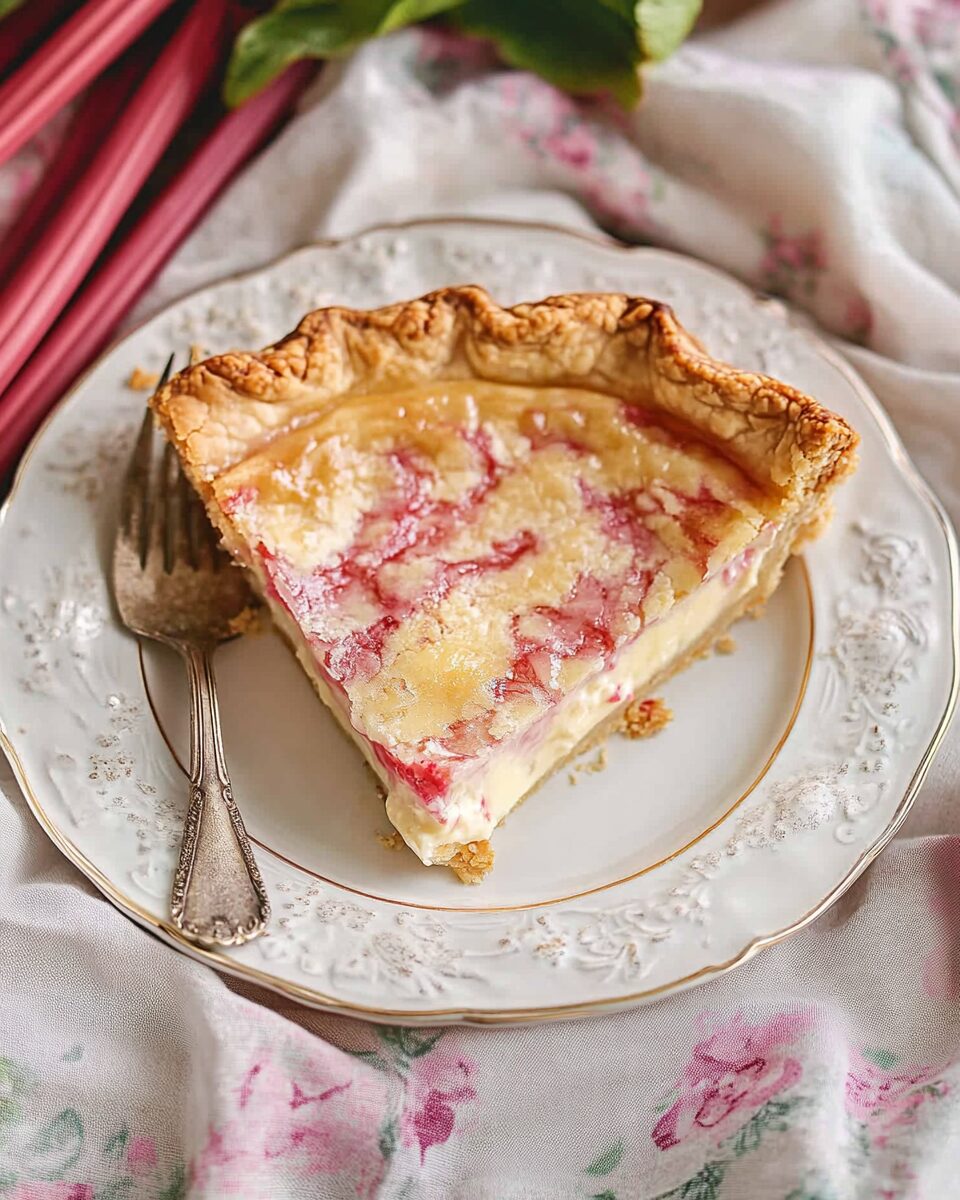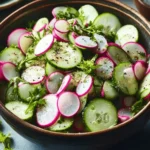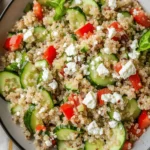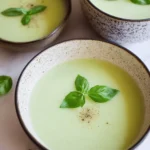A delightful vintage dessert, this easy rhubarb custard pie combines tart rhubarb with a sweet and creamy custard filling in a flaky pie crust. It’s a perfect spring or summer treat that highlights the unique flavor of rhubarb with minimal effort.
FULL RECIPE
Ingredients
- 1 unbaked 9-inch pie crust
- 3 cups fresh rhubarb, chopped
- 3 large eggs
- 1 ½ cups granulated sugar
- ¼ cup all-purpose flour
- ½ teaspoon ground nutmeg
- ¼ teaspoon salt
- 1 tablespoon butter, cut into small pieces
Directions
- Preheat the oven to 400°F (200°C).
- Place the unbaked pie crust into a 9-inch pie dish and crimp the edges.
- Spread the chopped rhubarb evenly in the bottom of the crust.
- In a mixing bowl, whisk together the eggs, sugar, flour, nutmeg, and salt until smooth.
- Pour the custard mixture over the rhubarb.
- Dot the top with pieces of butter.
- Bake for 10 minutes at 400°F, then reduce the heat to 350°F (175°C) and bake for an additional 40–45 minutes, or until the filling is set and the top is golden.
- Cool completely before serving. Chill for best results.
Nutritional Information
- Calories: 310 per slice
- Fat: 12g
- Carbohydrates: 47g
- Protein: 5g
- Fiber: 1g
- Sugar: 32g
- Sodium: 180mg
History and Origins of Rhubarb Custard Pie
Rhubarb custard pie is a classic dessert with roots that trace back to early American and European kitchens. Rhubarb, originally cultivated in Asia, was brought to Europe and later to America, where it became prized for its tart flavor and versatility. Combining rhubarb with custard was a natural evolution, offering a balance of tangy and creamy textures that appealed to many generations. This pie reflects the ingenuity of home cooks who used simple pantry staples to create comforting desserts.
The Role of Rhubarb in Baking
Rhubarb is unique among fruits because it is technically a vegetable. Its tartness can be intense, so when baked, it requires sweetness to balance its sharp flavor. Rhubarb’s fibrous texture softens beautifully in pies and custards, releasing its juices and creating a distinctive, slightly tangy taste that complements sweet custard.
Why Custard Works Well with Rhubarb
Custard adds a silky richness that tempers rhubarb’s acidity. Made from eggs, sugar, and dairy, custard binds the pie together and offers a creamy contrast to the fibrous rhubarb. The gentle cooking of custard also helps preserve the rhubarb’s bright flavor without overpowering it, creating a harmonious blend in each bite.
Choosing the Right Pie Crust
A flaky, buttery pie crust is essential for this dessert. It provides a sturdy base that supports the moist filling while adding a complementary texture. Whether using a homemade or store-bought crust, the key is to ensure it is well-chilled before baking to prevent sogginess and to achieve a golden, crisp edge.
Seasonal Availability of Rhubarb
Rhubarb is best fresh in spring and early summer, when stalks are tender and flavorful. During this time, the pie will have the most vibrant taste. Outside the season, frozen rhubarb is a good substitute, though it may release more liquid and require some adjustment in baking time or flour quantity to thicken the filling properly.
Nutritional Benefits of Rhubarb
Rhubarb is low in calories and rich in vitamins like K and C, as well as fiber and antioxidants. While the pie adds sugar and fat, it still offers some nutritional value from the rhubarb itself. Eating rhubarb in moderation can be a part of a balanced diet, especially in homemade desserts where ingredients are carefully controlled.
Tips for Perfect Custard Texture
Achieving the perfect custard requires careful mixing and baking. Over-beating can incorporate too much air, making the filling less smooth, while undercooking can leave it runny. A gentle baking temperature and checking for a slight wobble in the center ensures a creamy, set custard without curdling or cracking.
Common Variations of Rhubarb Custard Pie
Some variations add ingredients like strawberries or ginger to enhance flavor. Others swap nutmeg for cinnamon or vanilla extract for extra warmth. These small tweaks allow personalization while keeping the essence of the pie intact. Experimenting with different crusts, such as graham cracker or oat-based, can also bring new dimensions.
Storage and Serving Suggestions
Rhubarb custard pie is best served chilled or at room temperature. Leftovers should be refrigerated and consumed within three days to maintain freshness. Reheating gently in a low oven can restore some of the original texture. Serving with whipped cream or a scoop of vanilla ice cream elevates the dessert.
Understanding the Role of Flour in the Filling
Flour in the custard acts as a thickening agent, absorbing excess liquid released by the rhubarb during baking. This prevents the pie from becoming watery and helps the filling hold its shape when sliced. Using the right amount is important; too little results in a loose custard, too much can make it gummy.
How Nutmeg Enhances the Flavor Profile
Nutmeg adds subtle warmth and complexity to the pie. Its aromatic notes complement both the tartness of rhubarb and the sweetness of the custard. Even a small amount enhances the overall sensory experience, making the pie feel more comforting and nuanced.
Baking Techniques for Even Cooking
Starting the pie at a higher temperature helps set the crust and filling quickly, reducing sogginess. Lowering the heat afterward allows the custard to bake through without browning too much. Covering the edges with foil or a pie shield during baking prevents burning and ensures a uniform golden crust.
Common Mistakes and How to Avoid Them
Overfilling the pie can cause spillage and sogginess, so it’s important to follow measurements carefully. Using underripe or overly tart rhubarb without enough sugar can make the pie too sour. Baking times should be monitored closely to prevent a runny filling or a cracked surface.
Cultural Significance of Rhubarb Desserts
In many cultures, rhubarb desserts represent the arrival of spring, a time of renewal and fresh flavors after winter. This pie embodies nostalgia and tradition, often featured in family gatherings and holiday celebrations. It is cherished for its ability to evoke memories of simpler times and homemade comfort.
Pairing Rhubarb Custard Pie with Beverages
This pie pairs well with light, fruity wines such as Riesling or a crisp sparkling wine that complements the tartness. For non-alcoholic options, herbal teas or fresh lemonade highlight the pie’s fresh, bright flavors. Coffee and black tea provide a balanced bitterness that contrasts nicely with the sweetness.
Adapting the Recipe for Dietary Restrictions
The recipe can be modified to suit dietary needs. Using gluten-free crusts makes it suitable for gluten-sensitive eaters. Dairy-free custard can be made with plant-based milks, and sugar substitutes can lower the glycemic impact. Careful ingredient substitutions maintain the pie’s integrity while expanding accessibility.
The Science Behind Custard Setting
Custard sets as the proteins in eggs coagulate with heat, trapping moisture and creating a gel-like structure. The starch in flour reinforces this network, improving stability. Temperature control is vital to avoid overcooking, which can cause curdling, and undercooking, which leaves the custard loose.
The Importance of Cooling Before Serving
Allowing the pie to cool fully helps the custard to finish setting and prevents it from falling apart when sliced. Cooling also enhances flavor development, as the filling firms up and the ingredients meld. For best results, refrigerate the pie after cooling for at least a few hours.
Incorporating Rhubarb Custard Pie into Modern Menus
Today’s chefs and home bakers are rediscovering vintage desserts like rhubarb custard pie, valuing their simplicity and balanced flavors. It fits well into menus that emphasize seasonal, farm-to-table ingredients, and appeals to diners seeking nostalgic yet fresh desserts.
Conclusion
Easy rhubarb custard pie remains a timeless favorite due to its perfect harmony of tart rhubarb and creamy custard encased in a flaky crust. Its straightforward preparation and comforting flavors make it accessible to all levels of bakers, while its adaptability invites creativity. Whether served at a family dinner or a special occasion, this vintage treat continues to delight palates and preserve a piece of culinary history.






